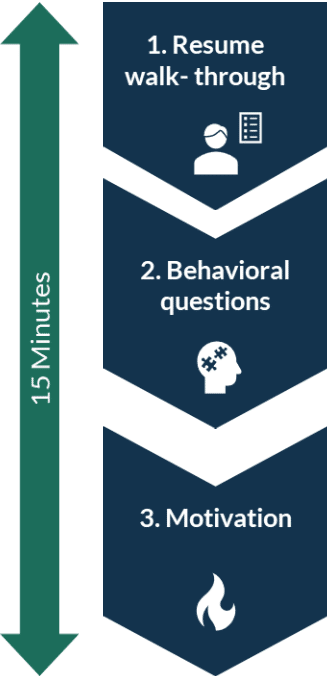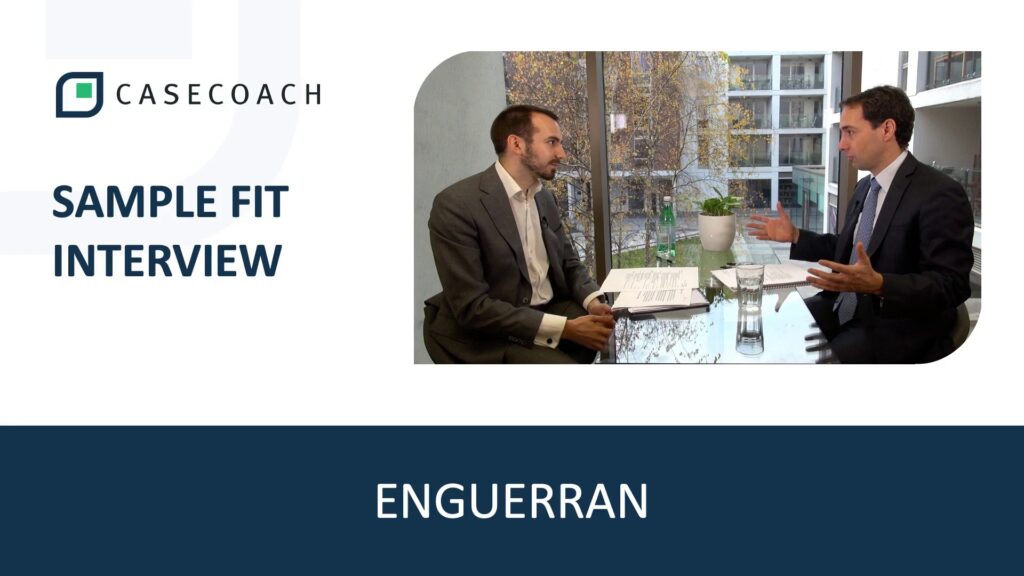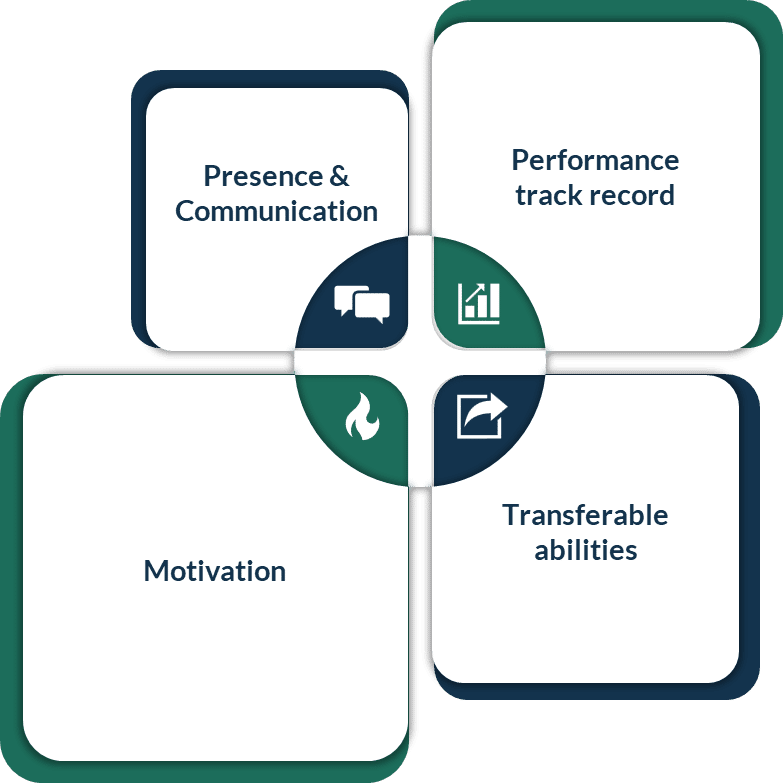What’s the consulting fit interview?
Fit interviews are part of the selection process at most employers. Top firms, such as McKinsey, BCG, and Bain (MBB), have developed their flavor of the fit interview to test whether candidates have the skills and character to deliver challenging projects and succeed in consulting.
Even though fit interviews represent half of the assessment, candidates tend to neglect this part in their preparation and prioritize the case interview instead.
In this article, we lift the veil on what a fit interview looks like, how to succeed in these types of job interviews, and how to prepare for them properly.
Key Takeaways
- While fit interview formats vary widely across consulting firms, candidates can typically expect a resume walkthrough and behavioral and motivation questions.
- Consulting fit interviews typically assess whether a candidate has the character and motivation to deliver on challenging projects and if they have the presence and communication skills necessary to represent the firm.
- BCG and Bain have varying fit interview formats across locations, though they usually include motivation questions (i.e., Why BCG/Bain?) along with other typical questions.
- McKinsey has a unique fit interview called a Personal Experience Interview (PEI) which usually takes around 15-20 minutes and will involve you talking about one specific achievement in detail.
- While there are wide varieties and nuances in fit interviews across Big-4 locations and practices, they typically include behavioral questions focused on dimensions that each firm communicates and may include technical expertise questions.
- To prepare for fit interviews, you should identify the dimensions assessed by the firms where you interview, prepare stories for each of these dimensions, not rehearse too much, and use the right resources.
The format of a typical fit interview
While the exact format of the fit interview varies significantly depending on the firm and interviewer, on average, candidates can expect a 15-20 minutes discussion that follows three steps:

Introduction of the candidate’s background (e.g., a “Walk me through your resume” or “Tell me about yourself” question)
A discussion of the candidate’s achievements and experiences (i.e., “behavioral” questions)
A presentation of the candidate’s motivation to become a management consultant at that particular firm (e.g., “Why consulting?” question)
The candidate will usually have time at the end of the interview to ask questions as well.
The most significant difference in fit interviews among top consulting firms is found at McKinsey, where the fit interview is named the “Personal Experience Interview” (PEI). In the PEI candidates are not formally asked to present their background or motivation; rather the PEI focuses exclusively on one specific achievement from the candidate’s experience (i.e., step two).
What a typical fit interview looks like
The video below features ex-consulting interviewers demonstrating a typical fit interview. It includes comprehensive feedback on how the candidate does as well.

Why fit interviews are used
Contrary to popular belief; the fit interview doesn’t evaluate whether the candidate fits with the culture of the firm; rather, it provides a means of testing the candidate’s abilities beyond the scope of the case interview and assessing whether they are likely to succeed on the job.
In particular, the interviewer is looking to answer whether the candidate has the skills, character and motivation to deliver on challenging projects and the presence and communication skills necessary to represent the firm.
What fit interviews assess
Each firm has specific characteristics in mind when evaluating a candidate’s skills, character, presence, and communication skills. These can be boiled down into four categories:
- Performance track record. Does the candidate have a track record of making an impact as a top performer in demanding environments?
- Transferable abilities. Does the candidate have specific abilities that will help deliver consulting projects? These vary somewhat by the firm, but they include persuasion, teamwork, entrepreneurial drive and leadership, adaptability and learning orientation, and an ability to work independently and under pressure.
- Motivation. Does the candidate have a clear and convincing rationale for why they desire to move into consulting at each specific firm?
- Presence and Communication. Can the candidate establish rapport with the interviewer, project professionalism and credibility, and communicate clearly and concisely?
This is a lot of ground to cover in 15-20 minutes, so it is essential to come prepared with concise answers to the questions you’re likely to be asked.

Fit interview differences across firms
The McKinsey PEI
The Personal Experience Interview (PEI) element of the recruitment process at McKinsey is quite different from the “fit” interview questions you may come across at BCG, Bain, or any other consulting firms.
Typically, you won’t be asked generic opening questions such as “Tell me about yourself” or “Why do you want to join McKinsey?” Instead, this part of the interview, which usually takes around 15-20 minutes of the full 45-50 minutes, will involve you talking about one specific experience in detail.
This makes PEI a very different “kettle of fish” to other typical interviews, so you need to prepare for them a little differently. Here are our top tips to help you prepare.
First, ensure you understand what dimensions McKinsey is testing for in the PEI. You are expected to demonstrate some key traits that align with the company culture of McKinsey, namely Inclusive Leadership, Personal Impact, and Entrepreneurial Drive. From these, interviewers aim to get to know you as a person — your drivers, interests, and how you deal with problems and people.
It’s also worth noting that the interviewer may interject to ask a specific question or encourage you to tell them more about a particular situation. Don’t be put off by this. The interviewer is looking for more content to assess you on and is likely trying to find a reason to mark you favorably on the key dimensions being tested — they just need to hear the evidence first!
We recommend watching the following video from McKinsey which explains what the Personal Experience Interview is and how McKinsey interviewers assess it.

BCG fit interviews
Each of your interviews at BCG will likely contain a fit portion. Fit interview time will be spent discussing your background, ambitions, achievements, and why you want to be a consultant. It may include some time to answer specific questions about a career at BCG.
There is typically no fixed format or agenda for BCG fit interviews, but interviewers often focus on an experience or a period of your life. As in a McKinsey PEI, your interviewers will seek in your stories evidence of abilities that will make you successful in consulting.
- Do you have high standards for yourself?
- Do you work well in a team?
- Do you have a track record of leadership and impact?
- Do you learn from your mistakes?
These are all things that BCG seeks in candidates. BCG also lists five qualities that their staff display, including:
- Intellectual curiosity
- Creative thinking
- Integrity
- Drive
- Collaborative mindset.
Make sure you prepare examples of times you have demonstrated each of these qualities for your fit interview.
In addition, unlike McKinsey, BCG will formally assess your presence and communication throughout the interview. Make sure to communicate as you would in regular conversation and speak as succinctly as possible. Listen closely to the interviewer and don’t be afraid to play back what you hear to confirm full understanding before providing answers. Also, ensure to keep the atmosphere positive and upbeat as much as possible while being genuine with your responses.
Bain fit interviews
In recent years, Bain has kept on revamping their recruitment process. This is to foster greater diversity in their teams, remove unconscious bias throughout the recruitment stages, and increase consistency between interviewers and locations.
In particular, Bain is reducing the weight of fit interviews as it has often been criticized for being a self-marketing exercise rather than a test of transferable abilities. Many offices have eliminated the fit interview from the first round to focus exclusively on cases.
That said, you are still very much likely to face a fit interview if you want to join Bain. The next two subheadings walk through Bain’s traditional fit interview and the changes being made in some locations.
Traditional Bain interview format
Bain’s traditional experience interview is geared toward learning about your accomplishments, understanding your motivations and passions, and identifying why you’re seeking a career in consulting at Bain.
Your interviewer may start by asking traditional résumé questions to gain a better understanding of your background, interests, and career goals. Some interviewers may conduct a mini-case based on your professional or academic experiences. The mini-case involves describing a strategic project you worked on and elaborating on the approach you and your team took to develop a hypothesis and recommendation, as well as the steps to implement the recommendation.
Fortunately, Bain does share a few questions that you may encounter in their interviews:
- Why are you interested in Bain?
- What experience are you most proud of?
- What experience do you wish you could do over, and how would you do it differently?
- What is a difficult decision you’ve made in the last year?
- What is an example of a time when you showed initiative and leadership?
- What aspects of your internship did you especially enjoy?
- What aspects of your internship did you like less?
- What do you most like to do in your free time?
- What attributes would you bring to a case team?
- Describe a role where you changed the direction of a team. How did you do it?
Changes to Bain’s fit interview format
In some European offices, candidates are tested by a new “behavioral and situational interview” format in which they often report being asked specific questions without sharing their resumes in a 45-minute session, one-on-one with a Bain Manager. In this kind of CV-blind fit interview, candidates are asked eight scripted questions focused on whether they have the transferable skills necessary to succeed at Bain.
The questions are a mix of behavioral questions (backward-looking) and situational questions (hypothetical situations). Themes include teamwork, the capacity to learn, and the ability to listen and empathize. For the behavioral questions, you can choose examples from your personal, academic, or professional experiences, but the context matters less than what you say about your thoughts and actions.
Unlike some other fit interviews in which the interviewer only dives deep into one of your experiences shown on your CV, Bain’s new fit interview format might feel mechanical and transactional as questions are scripted with no link between them. The interviewer may also interrupt your answer to move on to the next questions to ensure all eight questions are covered. So, don’t be too fazed if either of these happens.
Fit interviews at the Big 4 and Accenture
The Big-4 firms (PwC, EY, KPMG, Deloitte) and Accenture are larger than the top management consulting firms. They have distinct practices, including a strategy arm (e.g., Strategy& for PwC, Monitor Deloitte) and advisory practices. While it would not be possible to capture all interview variances and nuances across practices and geographies, there are some key principles that could help you stand out in Big-4 and Accenture fit interviews.
Some of these firms provide insights into what they are likely looking for in a fit interview. We share some of this advice below, with a caveat that they apply across all practices of the firms, and are not specific to their management consulting practice. Candidates should check with recruiters before interviews to ascertain if there is a specific interview format and/or assessment dimensions they should expect.
Deloitte
Deloitte (US) describe their fit interview as the time to showcase your achievements and experiences, by answering behavioral/motivational questions, as well as to display strong communication and interpersonal skills. Their fit interview typically requires candidates to describe situations where technical and functional capabilities were used, intellectual curiosity was displayed, and a passion for making a personal impact was evident.
Deloitte does provide some tips for a successful interview. This includes advice to pick up prompts that describe experiences and career/life periods reflected in your resume, focus on the positives of all your past experiences, and remain optimistic and relaxed as much as possible. They also encourage using some of this time to learn more about the firm.
Potential questions to expect include:
- Tell me about yourself.
- Tell me about your weaknesses.
- Tell me about your biggest failure at work.
- What does your ideal job opportunity look like?
KPMG
KPMG (UK) outlines nine focus areas for their fit interviews. For each of these, they expect you to give examples of how you’ve displayed specific behaviors. These can be from hobbies and academia to part-time jobs. In these examples, candidates should remember what they did, the role they played, and the challenges they faced. These focus areas include:
- Quality delivery. Your ability to plan, prioritize and prepare in advance to achieve exceptional results
- Collaboration and Inclusion. Your ability to thrive working in a team and to make lasting connections with colleagues and clients
- Drive for Continual Improvement. Your motivation to achieve your potential
- Professional Judgment. Your ability to analyze information and justify your approach with clarity and confidence
- Impact. Your ability to communicate passionately and professionally
- Business Acumen. Your passion for the commercial world, understanding of the external marketplace, and/or the issues clients likely face
- Innovation and Curiosity. Your problem-solving and ability to add value by embracing change and proposing creative and practical solutions
- Resilience. How you react to challenges and keep motivated whilst under pressure
Lastly, KPMG is looking to assess your Career Motivation. Why you want to work for KPMG in particular, and if you have thought carefully about your choice.
PwC
While PwC (Canada) provides general advice for fit interviews for their campus recruiting, they also advise candidates to get to know the five dimensions of the PwC Professional and to be ready to share their experiences in line with how you demonstrate these dimensions.
The five dimensions include:
- Global & Inclusive. How well you seek the perspectives and views of others and ask questions to enhance your understanding of people and places.
- Whole leadership. Your ability to lead, inspire, make a positive impact and deliver results.
- Relationships. How well you build meaningful, authentic, trust-based relationships.
- Business acumen. Your ability to bring business knowledge and awareness, or have a willingness to learn about business.
- Capabilities. Your technical and digital capabilities that create value for clients.
The most common types of fit interview questions
Walk me through your resume
The fit interview traditionally starts with the interviewer asking the candidate a simple (but often challenging!) question to summarize their background or experience.
Although this seemingly innocent question can feel like a pleasant “get to know you,” it’s easy to get tripped up by launching into a detailed monologue for five minutes.
Instead, a candidate should set the stage for a good conversation by providing a high-level view of who they are. In practice, this means preparing a 30-60 second introduction that will cover a lot of ground by offering a high level of abstraction without going into many details. This can be done by simply mentioning one’s current occupation, or by providing a brief summary of one’s professional journey, academic background, or noteworthy extracurriculars.
To learn more about how to do this well and to see an example, watch the video below.

Behavioral questions
Questions assessing behavior typically require a candidate to talk about a past achievement. They typically start with “Tell me about a time when…”. Talking about achievements is one of the best ways to demonstrate transferable abilities. It comes up in most fit interviews and is the focus of McKinsey’s Personal Experience Interview (PEI).
We have listed below two of the most common mistakes we have observed while answering behavioral questions.
Mistake #1: Wrong achievements
One of the most common mistakes candidates make is talking about the wrong achievements: situations that are not particularly challenging, where results are not particularly positive, where the candidate hasn’t displayed many actions, or has displayed actions that don’t illustrate skills useful for consulting.
After all, there are reasons why firms use these questions to assess whether the candidate can get things done on the job. They are looking for evidence of traits such as persuasion, teamwork, entrepreneurial drive and leadership, adaptability and learning orientation, and an ability to work independently and under pressure.
To avoid a potential pitfall, candidates should identify their most significant achievements and be ready to talk about them. This allows them to stand out among other candidates on the day and demonstrate an impressive performance track record.
Mistake #2: Too much context
Another common mistake is to spend too much time explaining the details of the context and not enough time on the actions.
When it comes to telling stories of achievement, take inspiration from the best storytellers — the movies! They all follow the same framework of a situation, followed by a complication, actions, and, finally, a conclusion, or results. This approach makes for better stories than the widely-used “STAR” framework.
Let’s break this down a bit more.
1. Situation
In a good movie, the situation starts in a way everyone can understand. When sharing a story of achievement, it’s important to only share the context that is required to comprehend the story, their role, their goal, and the key stakeholders. It should be short but sufficient.
2. Complication
Second, a great movie has a big problem, a turn of events or challenges to be resolved. Candidates should be sure to describe the complication that was faced in a way that shows how it was an important and difficult situation to overcome. This is where the interviewer’s interest is hooked. The context of a tough challenge and the establishment of tension makes it easier to see an achievement as impressive.
3. Resolution
Third, there’s always a lot of action in great movies! It’s important to make sure to describe one’s actions. This is where most of the content lies. Ultimately, it’s what was done and why that will score points.
4. Results
Just like in a good movie, a good story always has a great ending. It is important to share the results created and how things were different afterward. Following these four simple and effective steps allow for achievements to be conveyed in an efficient and compelling way.
Sample questions and answers
To further illustrate how to approach behavioral questions, below are two videos showing sample behavioral questions answered by the founder of CaseCoach. Here, he is presenting himself as when he was an MBA student at Columbia Business School, before joining McKinsey.
Behavioral question:
When have you been able to influence/persuade someone to change an opinion/mindset/behavior when you weren’t in a position of authority?

Behavioral question:
Tell me about a time you managed to set an ambitious goal and describe how you went about achieving it.

Motivation questions
Candidates frequently receive questions such as “why consulting?” and “why did you apply to this firm in particular?”.
When answering these questions — which usually come toward the end of the fit interview — it’s helpful to avoid generic responses that any other candidate might come up with, such as “I want to work for a prestigious firm.” Candidates should also avoid explaining their motivation regarding goals that they’ve not mentioned earlier in the interview or that are not consistent with the choices made earlier in their career. This could cause a candidate to come across either as not being fully honest or as not having properly thought through their rationale.
To be a strong candidate, it is important to have prepared reasons specific to and consistent with one’s journey thus far. Researching the firm and office one is applying to is an important factor here. As part of your research, it’s a good idea to learn about what life is like at your firm of choice:
Answering “Why this firm?”
One of the most common motivation questions seeks to evaluate how much interest the candidate has specifically in their firm as opposed to just the industry in general. It usually comes in the form of “Why do you want to work here”? or “Why this firm?”
One way to answer this is by mentioning any personal connections you have to the firm. You should mention people at the firm you know or have met and have had a positive impression of the company from your conversations with them. This shows that you’ve done your homework and have built some connections to the firm.
Other than name-dropping some current staff or alumni you’re acquainted with in your interview, it will help put you in good standing if you can come up with some concrete examples about the firm, their work, or the people there that are aligned with your narrative. Here, it is important for you to have a grasp of what is unique about the firm.
Answering “Why BCG?”
To answer “Why BCG?”, mentioning three key areas below where BCG’s culture differs from others could be a good starting point. First, BCG puts no pressure on people to conform, whether internally amongst colleagues or externally with clients. The firm promotes diversity. In essence, there is no “BCG way of working” or “BCG way of acting” or “BCG way of being.” If you are someone who values individuality and flexibility, as opposed to conforming to cultural expectations, you could definitely elaborate on how this value proposition of BCG resonates with you.
Secondly, BCG has its distinctive strengths-based feedback approach. Believing that feedback should be built on differentiating the strengths of the individual rather than their weaknesses, BCG works on zooming in on an individual’s strengths to nurture them and turn them into a platform on which they can progress. In turn, by spill-over, the weak areas also improve. This approach creates a highly supportive environment that still develops and stretches consultants at BCG.
Last but not least, BCG is a collaborative and fun firm. This might go in contrast with your expectation of a cut-throat environment in a top consulting firm, but it is a consensus among current and former BCG employees that BCG is an enjoyable place to work. With a myriad of social events, the firm hopes to break down the barriers between cohorts, levels of seniority, and consultant/non-consultant staff. And they succeed. It’s not uncommon to find friendships between principals and associates, or partners and consultants. The support network that fellow colleagues provide is a key contributor to a long-lasting and fulfilling career as a BCG consultant.
Answering “Why Bain?”
The same applies to answering “Why Bain?”. The first differentiator is team structure. Unlike other top consulting firms, Bain has a slightly more hierarchical and meritocratic structure. Unlike at McKinsey and BCG, where team members each have their own workstream and report to the same team leader, Bainies often have an oversight role over consultants of a level below. This allows consultants at Bain to gain managerial responsibility faster than at other firms. It also means a more fluid career because Bain rewards its top performers with faster career progressions and is very flexible with letting consultants climb several notches in one go if their performance shows that they’re ready.
Another unique value proposition of Bain is its philosophy of “a Bainie never lets another Bainie fail.” It essentially means colleagues are willing to help each other out, especially when someone is facing challenges. This collaborative culture is an important part of consultants’ professional development and is often considered unique to Bain.
As with many top consulting firms, Bain’s culture is also very feedback-focused. This is to ensure consultants are constantly growing and developing both their hard and soft skills. Although the feedback culture can feel intense at times, you’re always very aware of what you need to focus on to be better at your job. This means that you learn and develop at a rapid pace.
What’s more, the culture of Bain cannot be missed out if you are looking for a flexible and fun career in consulting. The Bain culture is known for its high energy and focus on working hard while also enjoying the ride. From numerous team events, social occasions, office parties, and getaways, Bainies can connect, build relationships, and have fun. Their World Cup event, which brings together thousands of employees from across the world to compete in sports and celebrate, is also a big thing that cannot be found in other firms. The fun part extends to your work as Bain provides flexibility for employees to explore a personal interest or take extended leave for a long vacation without jeopardizing your career. If you are enthusiastic to thrive in this kind of environment, point this out to your interviewer!
Curveballs
While curveball questions are unlikely to show up in fit interviews due to time constraints, preparing for them is nevertheless a useful precaution to take. Some curveball questions could be:
- Tell me about a failure.
- Tell me why I should hire you.
- Tell me about your strengths and weaknesses.
- Tell me about negative feedback you have received.
- Tell me about an experience you did not like.
- Are you interviewing at other firms?
- If I made you an offer, would you accept right away?
- Where do you see yourself in ten years?
Questions for the interviewer
At the end of a consulting interview, the candidate normally has a few minutes to ask questions to the interviewer. The questions asked here are not formally assessed, but they contribute to making the interviewer excited (or not!) about the candidate.
It’s worth noting the questions that really shouldn’t be asked. Some of this may sound obvious, but a surprising number of candidates still put their foot in it. Candidates should avoid asking the interviewer to talk about the negative parts of their job or the firm. Similarly, avoid challenging the interviewer, for instance by asking why you should join that specific firm over one of its competitors. Another type of question to avoid is anything factual that could be answered by reviewing the website.
Good questions build a connection with the interviewer and/or demonstrate a candidate’s motivation to join the firm.
To prepare relevant connection-building questions to ask at the end of a consulting interview, candidates should arrive at least 15 minutes early, read the short bios that are provided about each of the interviewers, spot what they have in common with them, and use that for their questions. If commonality is not found, the candidate can ask general questions about the interview’s experience at the firm.
How to prepare for the fit Interview
While the fit interview is often overlooked by candidates, it must be prepared for properly. It is still 50% of the assessment. Candidates should keep four things in mind when preparing for fit interviews:
- identify core dimensions,
- prepare your stories,
- don’t rehearse too much, and
- use the right resources.
Identify core dimensions
As shown earlier in this article, top consulting firms typically have a number of dimensions that capture the core qualities they look for in candidates. You can find the right dimensions for your applicable firm on their websites, in material shared with you by their recruiters, or in any information session held by the company.
Prepare your stories
With the dimensions in mind, draft a few items at a simple bullet point level. These should include a short introduction of your background with a clear narrative, answers to typical fit interview questions, and your top 5-6 achievement stories that you’d like to use in your interviews.
We recommend not repeating the same story within the same interview round because when the interviewers triangulate scores at the end of the day, you want to have shown a variety of achievements, rather than risk looking like a “one trick pony.”
The difficulty in most interviews resides in telling these stories concisely while saying enough to impress and get into the details of your actions. For this, we recommend a simple framework with proven success: share the situation, explain the main challenges, describe your actions, and conclude with the results.
You should be prepared to speak in detail about your actions and ensure that they are relevant to the dimension being tested.
Don’t rehearse too much
We recommend you practice telling your stories, in case retelling them prompts any more details you’d like to share, but we do not recommend scripting your stories word-for-word or rehearsing more than a couple of times (ideally 3-5 live fit practices).
An over-rehearsed achievement story runs the risk of making you come across as over-prepared. Instead, you want to make the interview feel like a conversation between you and your interviewer
Use the right resources
CaseCoach’s Fit Interview Prep Course, included in our Consulting Interview Prep Toolkit, provides all the resources you need to prepare for the fit interview. It includes video classes covering how to introduce yourself, present your track record and motivation, and demonstrate your abilities. The course also provides 9 fit interview video examples featuring real undergrads, MBAs, PhDs, and experienced candidates who went on to join top firms, with detailed analyses of their performance.
In our Consulting Interview Prep Toolkit, you’ll also find course dedicated to McKinsey’s Personal Experience Interview. In the course, we go into detail about the kind of evidence interviewers are looking for in each dimension assessed by McKinsey, and share additional tips on choosing and telling your stories. We also show you examples of PEI interviews in videos featuring real candidates who joined McKinsey.
CaseCoach’s team of coaches are former consultants and interviewers, handpicked from among the alumni of top firms such as McKinsey, BCG, and Bain. They are available to deliver fit and Personal Experience Iinterview coaching in a realistic setting to put candidates’ preparation to the test, providing the personal feedback and practical advice needed to ace these interviews.







